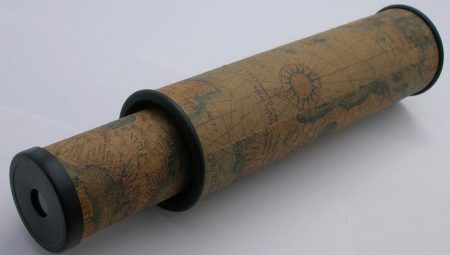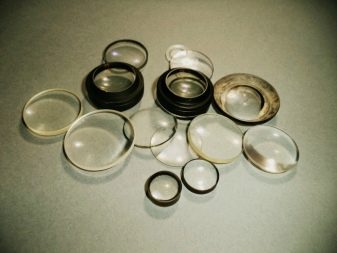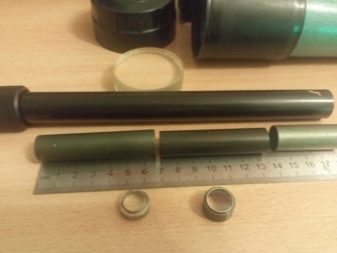How to make a spyglass with your own hands?

A spyglass, like binoculars, is much easier to manufacture than a telescope and a microscope. It will require any lenses - plastic or glass. The latter are more difficult to obtain and more expensive.


Option for children
To make a spyglass for use by children and teenagers of primary school age, DIY parents take about the same approach as for binoculars. The only difference compared to binoculars is that they use a pair of lenses and eyepieces, while telescopes and telescopes use only one eyepiece and a lens. A homemade telescope can be made according to the following instructions.
-
Roll up a tube from cardboard or whatman paper. Fasten it from the ends with potholders (like clothespins) in two places on each side so that it does not unwind. Saturate it with glue (such as epoxy). It is important that the glue penetrates into the thickness of the paper material from which the sheets are made and holds them together. Rough, matte paper is even better - it has a surface that creates the necessary adhesion to itself. Wait until the glue absorbed into the paper hardens - it will gain strength. You can use pre-made rolls of wallpaper, toilet paper, roll napkins, agrofibre or paper towels.


-
Cover the inside of the tube with black compound. It can be ink, black watercolor, or industrial synthetic paint.If a child or teenager assembles everything with his own hands under your guidance, make sure that the materials - glue, paint - are non-toxic, and therefore it is better to abandon some industrial dyes. The black surface absorbs light rays refracted by the spyglass lenses, preventing the viewed object from blurring and glaring in your eyes.

-
Fix the lenses with hot melt glue. The simplest tube consists of a diffusing lens in the eyepiece and a collecting lens in the objective. When attaching the lenses, position them so that their optical centers coincide - this is important to preserve vision by reducing eye fatigue.


- Cover the outside of the pipe with paint of a different color.... Black is optional.


The simplest telescope is ready. A slightly more complicated version is made using two tubes, one of which fits into the other due to the small difference in diameter. The result is an increase in the object observed from afar by several times (in the image).
The children's spyglass does not contain extra lenses, but it provides the same magnification factor as the simplest binoculars.


Making a pipe for adults
The "adult" tube contains significant improvements: a PVC tube tube, up to several lenses in the objective, an additional lens that flips the enlarged inverted image formed between multiple focal marks, and an aperture. To observe the sun, light filters and tinted glass are used, which reduce the brightness of sunlight within 95-99%. A telescope in which the lens is large enough can be used to observe the Moon and the Sun, in the latter case, subject to safety precautions. Such a tube also allows you to see clearly what is happening, for example, in the house opposite (with open windows), it is also used for remote video filming, for example, chess games from a long distance.
The possibilities of such a tube, indeed, are much more - it is used by sailors, amateur astronomers to observe the Moon, oceanographers and topographers to survey the area, and so on. To make it, follow the instructions below.
-
Find the best inner diameter plastic tube for your lenses. The water supply (small) is not suitable here - the lenses are too large, it is used only for the manufacture of microscopes, "camera scopes" for smartphones used for biomedical purposes. For a telescope, sewer pipes are more suitable - with a diameter of several centimeters.

-
Saw off the necessary pieces from the pipe of slightly larger and slightly smaller diameters... For example, these are two pieces of 25-30 cm.

-
If the pipe is not black, cover it from the inside with black varnish, paint. It is not recommended to use tar, bitumen primer and other oil products - they will evaporate in the heat, becoming toxic to humans. The paint must be air dry.

-
Calculate from the drawing you took as an instruction and cut out the damper with a hole in the middle. It acts as a diaphragm. Insert it inside one of the pipe pieces and fix it with hot glue, Moment-1 glue or epoxy.


- Fix the lenses in a similar way (eyepiece, objective, intermediate)... In professional telescopes, only magnifying (collecting lenses) are used - their location is precisely indicated on the drawing. Try to keep exactly the distance between them, otherwise the image may turn out to be indistinct, insufficiently enlarged and / or inverted.


Making a homemade telescope in its more "advanced" version will not be a problem either.
Compared to the "children's" version, this one is much more durable, gives an increase of 10-20 times, is suitable for everyone who often goes hiking or even travels around the world, goes to nature - to observe the cities and the landscape from afar.


Helpful hints
Lenses inserted into the pipe should be positioned so that the plane passing through the edges of the collecting (double) convex lens is perpendicular to the pipe walls (in the projection along the length of the latter). The slightest deviation will immediately lead to "blur" of the image. It is useful to expose eyepiece lenses when there is an industrial magnifying lens nearby, in the tube of which its own lenses are adjusted (exposed) at the factory.
Do not look at the sun without filters or shading. Otherwise, you can get irreversible damage to the eyes (burn the retina), up to complete loss of vision. And it is also forbidden without darkening, for example, to observe through a pipe or binoculars at electric welding, industrial arresters, quartz lamps and other devices emitting hard ultraviolet light.


Next, watch a workshop on making a telescope for children's games.








